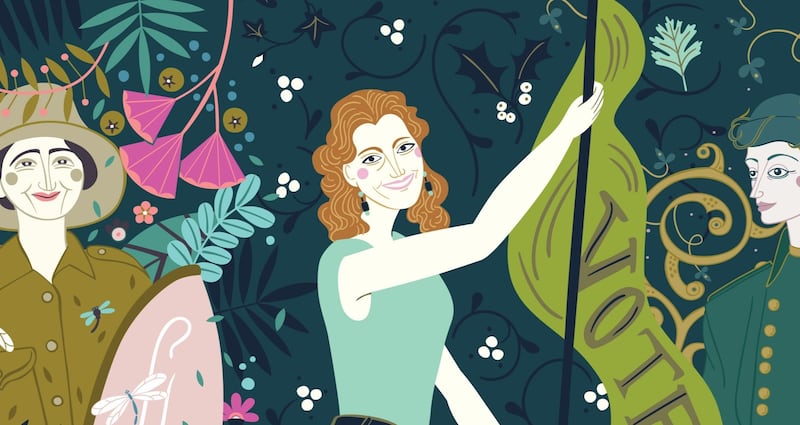Kathleen Lynn was born on January 28th, 1874, in Mullafarry, near Cong in Co Mayo, the second oldest of three daughters and one son of Robert Lynn, Church of Ireland clergyman, and Catherine Lynn (nee Wynne) of Drumcliffe, in Co Sligo. Despite aristocratic relations and a comfortable upbringing, her professional career was primarily concerned with the less well off.
Lynn's Mayo childhood, in which poverty coincided with land agitation, may have motivated her to seek political and pragmatic solutions to socioeconomic deprivation. After education in Manchester and Düsseldorf, she attended Alexandra College in Dublin. She graduated from the Catholic University medical school, on Cecilia Street, in 1899, and, after postgraduate work in the United States, became a fellow of the Royal College of Physicians in 1909. She was refused a position at the Adelaide Hospital because of her sex, and eventually joined the staff of Sir Patrick Dun's Hospital. She also gained valuable experience at the Rotunda maternity hospital. From 1910 to 1916 she was a clinical assistant at the Royal Victoria Eye and Ear Hospital in Dublin, the first woman resident doctor at the hospital, but was not allowed to return after the 1916 Rising. Her private practice, at 9 Belgrave Road in Rathmines, was also her home between 1903 and 1955.
Lynn's work in soup kitchens brought her into close contact with impoverished families in Dublin during the 1913 lockout of workers

An active suffragist and an enthusiastic nationalist, Lynn was greatly influenced by the labour activists Helena Molony, Constance Markievicz and James Connolly. Her work in the soup kitchens brought her into close contact with impoverished families in Dublin during the 1913 lockout of workers. She joined the Irish Citizen Army and taught first aid to Cumann na mBan. As the Citizen Army's chief medical officer during the Easter Rising she tended to the wounded from her post at City Hall, and her car was used for the transportation of arms and for Markievicz to sleep in. Imprisoned in Kilmainham Gaol, with her close friends Molony and Madeleine ffrench-Mullen, she complained bitterly about the cramped prison conditions.
A committed socialist, she was an honorary vice-president of the Irish Women Workers’ Union in 1917 and denounced the poor working conditions of many women workers. She was vice-president of the Sinn Féin executive in 1917, and her home was a meeting point for fellow Sinn Féin women, notably for meetings of Cumann na dTeachtaire (or League of Women Delegates). On the run between May and October 1918, she was sent to Arbour Hill detention barracks when arrested. The authorities agreed to release her, on the intervention of the lord mayor of Dublin, Laurence O’Neill, as her professional services were essential during the 1918-9 influenza epidemic. Despite her high political profile Lynn is remembered primarily for her work at St Ultan’s Hospital for Infants, on Charlemont Street in Dublin, which she established in 1919 with ffrench-Mullen. Its philosophy was to provide much-needed facilities, both medical and educational, for impoverished infants and their mothers.
Although Lynn was active in south Tipperary during the War of Independence, her national prominence faded after the heady 1913-23 period. In 1923 she was elected to Dáil Éireann as Sinn Féin candidate for Dublin county, as an opponent of the Anglo-Irish Treaty of 1921, but did not take her seat. She failed to retain her seat in the June 1927 election but was an active member of Rathmines urban district council between 1920 and 1930. She commented regularly on public-health matters such as housing and disease prevention.
As council member of the Irish White Cross she endeavoured to help republicans and was very critical of the newly formed Irish Free State’s attitude to anti-treatyites.
Lynn preached the virtues of cleanliness and fresh air. Her friend Michael Scott, the architect, designed a balcony outside her bedroom, where she slept for most of the year
At St Ultan's Lynn fostered international research on tuberculosis eradication. In 1937, through the efforts of her colleague Dorothy Stopford-Price, the hospital introduced BCG, or Bacillus Calmette-Guérin, inoculation, which prevented tuberculosis. She also encouraged links with US and continental medical practitioners. Ffrench-Mullen and Lynn visited the United States in 1925 to raise funds for St Ultan's and visit paediatric institutions. Lynn's interest in child-centred education was furthered in 1934 when Dr Maria Montessori visited St Ultan's.
Throughout her life Lynn preached the virtues of cleanliness and fresh air. She was involved with the An Óige youth organisation and gave them her cottage in Glenmalure, Co Wicklow (which she had previously lent to Dorothy Macardle for the writing of The Irish Republic). Lynn's friend Michael Scott, the architect, designed a balcony outside her bedroom, where she slept for most of the year.
A devout member of the Church of Ireland, she worshipped regularly at Holy Trinity Church in Rathmines, but often criticised the Christian churches for losing sight of Christ’s original teaching. After the second World War she was vice-chairman of the Save the German Children Society.
She died on September 14th, 1955, at St Mary's Nursing Home in Dublin and was given a full military funeral. Remembered primarily for her sociopolitical activism, she was part of a generation of women who were politicised in the 1910s and who devoted their later careers to maternal feminism. A portrait by Lily Williams is in the Royal College of Physicians in Dublin.
From the Royal Irish Academy Dictionary of Irish Biography, published by Cambridge University Press










